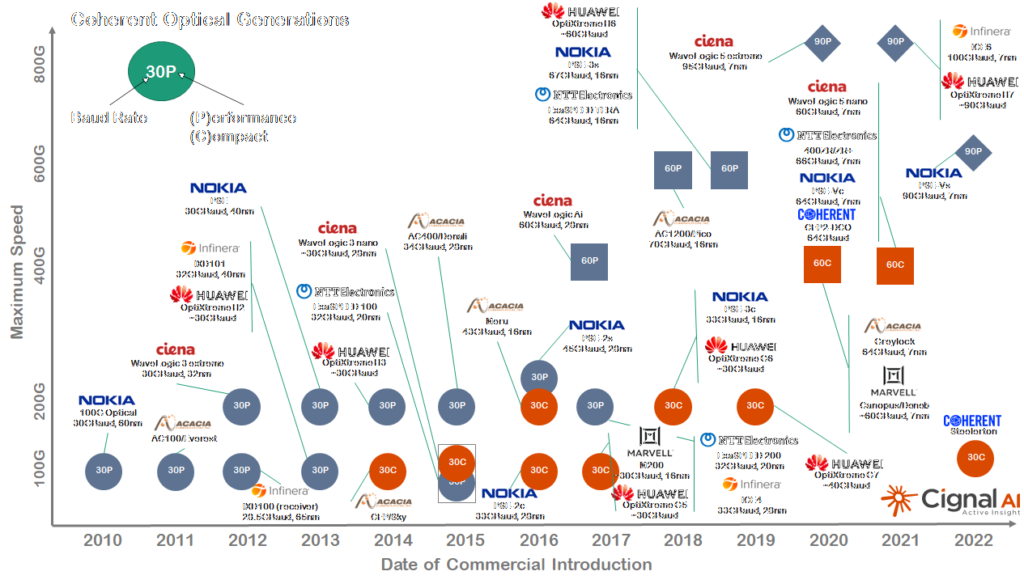
It has been three years since a new high-performance coherent optical generation was commercially introduced. The chart below shows that Gen90P (800Gbps) coherent optics were initially deployed commercially in early 2020 by Ciena, followed by Infinera, Huawei, and Nokia. The previous generation (Gen60P) was commercially introduced three years earlier in 2017, suggesting that now in 2023, it is about time to welcome another new generation.

For details on how Cignal AI classifies coherent optical generations, read our Active Insight Report 400ZR vs. 800G – Classifying Coherent Technology.
Last week, Acacia/Cisco announced that their Gen120P (1.2Tbps+) solution has started shipping to customers, and last year NEL announced the development of a Gen120P DSP solution. Expect more such announcements from equipment and component vendors at OFC23 as Gen120P becomes a reality. Some announced solutions may offer slightly higher baud rates or top speeds of 1.6Tbps. But with the inevitable diminished returns on performance as solutions reach the Shannon Limit, what is the selling point of Gen120P?
Diminishing Returns and Cost-per-Bit
Successive generations of high-performance optics have moved performance closer to the theoretical maximum capacity of fiber with techniques including subcarriers, probabilistic shaping, and enhanced FEC. As a result, the spectral efficiency (usable traffic in a specific bandwidth range) has effectively maxed out. While earlier transitions (e.g., Gen30P to Gen60P) could boast of more bandwidth on a single fiber, that is no longer true with the transition to Gen120P. Instead, this latest generation will push signals over longer distances and reduce overall cost-per-bit on routes that require optimal performance.
Coherent optics are rarely deployed at their maximum advertised rate. This is because rate and distance are inversely related, so deploying coherent optics at a lower rate means signals can be sent over longer distances. The tradeoff between distance and speed can be seen in the diagram below, where the maximum distance reported for a Gen90P deployment at 400Gbps is almost four times longer than at 800Gbps.

Source: Active Insight report GEN90P Coherent Trials and Deployments
Due to the capability of coherent optics to travel further at lower speeds, Gen60P (400/600Gbps) and Gen90P (800Gbps) optics have been primarily deployed to transport 400Gbps signals over distances of up to a few thousand kilometers. Gen120P will focus on deploying 800Gbps signals over similar distances. While 800GbE will be a less popular client interface, some data center operators will use 800Gbps coherent links to transport 2x400GbE. This is especially true over long distances (e.g., submarine networks), where the fiber spectrum is most valuable.
Gen120’s claim to lower cost-per-bit comes from increasing the capacity per laser and the hardware required to run those lasers (DSPs, receivers, etc.). While the fiber may carry the same capacity as earlier coherent generations, fewer lasers and associated hardware are required with Gen120P. Therefore, especially on long-haul routes where spectral efficiency is maxed out, Gen120P will offer cost savings.
Pluggables Closing the Gap
Any discussion of Gen120P at OFC23 would be remiss if it did not mention the corresponding Gen120C pluggable solutions. For the first time in history, Performance and Compact versions of the same baud rate generation will come out in the same year. Gen120C, which should be available by the end of the year, will be used in 800ZR modules specified by the OIF for use between data centers. As with Gen120P, one of the most important benefits will be long-distance operation at 400Gbps – a new, long-haul 400ZR+ variant. While it may be a little early for product announcements at OFC23, the underlying technologies for Gen120C (modulators, optical front ends) will certainly make an appearance.
Gen120P at OFC23
High-performance coherent optics have the big numbers that gain the most attention in optics. They get faster and operate over longer distances with each generation. After a couple of years without a new jump in technological capabilities, Gen120P is set to make a big splash at this year’s OFC. Product shipments (to network operator’s labs) will be close behind, with commercial deployments expected sometime in the second half of this year.
